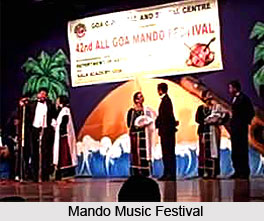 Mando or Manddo is a form of a Goan music that developed during the 19th and 20th century. This type of a music forms the culminating point of the Indian and western musical traditions. The music upholds both the Indian and western culture and has elements representing both the cultures. In Mando music the men put on formal coats depicting the Portuguese influence while on the other hand women adorn themselves in exclusive Indian costume which are known as bazu torop or pano baju. During the Mando Dance the ceremonial torhop-baz was worn which is made of velvet or silk and are red, blue or green in colour. It is embroidered with gold and rarely with silver threads. A white or blue shawl is also worn around. The slippers worn during the performance are ornamented and the socks were usually white in colour. The overall dressing is further enhanced by a graceful fan. The addition of the fan adds to the charm and style of the lady`s mood. The plural of manddo in Konkani is mande. The major themes on which mandos are performed are love, historical narratives, grievance against exploitation and social injustice, and political resistance during the Portuguese presence in Goa.
Mando or Manddo is a form of a Goan music that developed during the 19th and 20th century. This type of a music forms the culminating point of the Indian and western musical traditions. The music upholds both the Indian and western culture and has elements representing both the cultures. In Mando music the men put on formal coats depicting the Portuguese influence while on the other hand women adorn themselves in exclusive Indian costume which are known as bazu torop or pano baju. During the Mando Dance the ceremonial torhop-baz was worn which is made of velvet or silk and are red, blue or green in colour. It is embroidered with gold and rarely with silver threads. A white or blue shawl is also worn around. The slippers worn during the performance are ornamented and the socks were usually white in colour. The overall dressing is further enhanced by a graceful fan. The addition of the fan adds to the charm and style of the lady`s mood. The plural of manddo in Konkani is mande. The major themes on which mandos are performed are love, historical narratives, grievance against exploitation and social injustice, and political resistance during the Portuguese presence in Goa.
The accent of Mando Music is in Konkani is almost on the last syllable. In classical Mandos the dialect used is the Bambonn Saxtti of Salcete. This dialect is mostly spoken in the villages of Benaulim, Curtorim, Loutolim and Raia. It is from these villages that the dialect has originated. Bambonn Saxtti is considered as the most musical of the Konkani dialects. The prominent characteristic of this language is that the words are stretched etra long with an addition of an extra vowel that are fixed in the either in the middle or at the end of the words. Hence the word dista is stretched to disota and sanddlear into sanddilear. The suffixes -i and -o are commonly used to add an extra syllable to a line.
Mando is generally a monologue but in some mandos one person addresses the other one who in turn replies. Singing is accompanied by gentle swaying sideways according to the rhythm. This creates a soothing visual and auditory effect for the audiences.




















